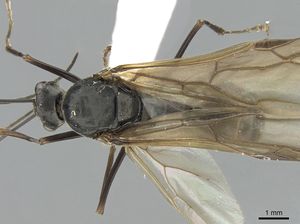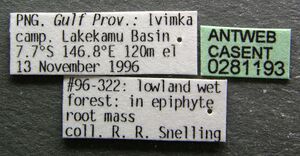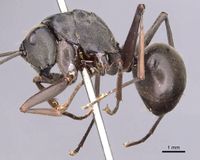Polyrhachis continua
| Polyrhachis continua | |
|---|---|

| |
| Scientific classification | |
| Kingdom: | Animalia |
| Phylum: | Arthropoda |
| Class: | Insecta |
| Order: | Hymenoptera |
| Family: | Formicidae |
| Subfamily: | Formicinae |
| Tribe: | Camponotini |
| Genus: | Polyrhachis |
| Subgenus: | Myrma |
| Species: | P. continua |
| Binomial name | |
| Polyrhachis continua Emery, 1887 | |
| Synonyms | |
| |
Specimens have been collected from an ephiphyte root mass in lowland rainforest.
Identification
A member of the Polyrhachis continua species group in the subgenus Myrma
Kohout (2008) - Like other members of the species-group, P. continua has an evenly curved mesosomal dorsum that lacks a distinct border between the propodeal dorsum and declivity, and has postocular and lateral ridges on the head (Kohout, 1989; 1998).
Keys including this Species
Distribution
Polyrhachis continua is known from the Moluccas (Ternate I.), New Guinea (Paumomu R.) and Sulawesi. (Kohout 2008)
Latitudinal Distribution Pattern
Latitudinal Range: 0.789388° to -7.734722222°.
| North Temperate |
North Subtropical |
Tropical | South Subtropical |
South Temperate |
- Source: AntMaps
Distribution based on Regional Taxon Lists
Indo-Australian Region: Indonesia (type locality), New Guinea, Sulawesi.
Distribution based on AntMaps
Distribution based on AntWeb specimens
Check data from AntWeb
Countries Occupied
| Number of countries occupied by this species based on AntWiki Regional Taxon Lists. In general, fewer countries occupied indicates a narrower range, while more countries indicates a more widespread species. |

|
Estimated Abundance
| Relative abundance based on number of AntMaps records per species (this species within the purple bar). Fewer records (to the left) indicates a less abundant/encountered species while more records (to the right) indicates more abundant/encountered species. |

|
Biology
Castes
Worker
Images from AntWeb
   
| |
| Worker. Specimen code casent0281392. Photographer Estella Ortega, uploaded by California Academy of Sciences. | Owned by PSWC, Philip S. Ward Collection. |
   
| |
| Syntype of Polyrhachis continua. Worker. Specimen code casent0905616. Photographer Z. Lieberman, uploaded by California Academy of Sciences. | Owned by MSNG, Genoa, Italy. |
   
| |
| Holotype of Polyrhachis continua. Worker. Specimen code casent0905820. Photographer Will Ericson, uploaded by California Academy of Sciences. | Owned by MSNG, Genoa, Italy. |
Queen
Images from AntWeb
    
| |
| Queen (alate/dealate). Specimen code casent0281194. Photographer Estella Ortega, uploaded by California Academy of Sciences. | Owned by PSWC, Philip S. Ward Collection. |
Male
Images from AntWeb
     
| |
| Male (alate). Specimen code casent0281193. Photographer Estella Ortega, uploaded by California Academy of Sciences. | Owned by PSWC, Philip S. Ward Collection. |
Nomenclature
The following information is derived from Barry Bolton's Online Catalogue of the Ants of the World.
- continua. Polyrhachis continua Emery, 1887a: 235, pl. 4, fig. 21 (w.) INDONESIA (Ternate I.). Combination in P. (Myrma): Emery, 1925b: 200. Senior synonym of revocata: Kohout, 1998: 519.
- revocata. Polyrhachis continua var. revocata Viehmeyer, 1913: 151 (w.) INDONESIA (Sulawesi) (in copal). Combination in P. (Myrma): Emery, 1925b: 200. Junior synonym of continua: Kohout, 1998: 519.
Unless otherwise noted the text for the remainder of this section is reported from the publication that includes the original description.
Description
Worker
Kohout (2013) - Dimensions (holotype cited first): TL c. 10.18, 9.42-10.68; HL 2.50, 2.31-2.59; HW 1.81, 1.65-1.87; CI 72, 70-74; SL 3.48, 3.12-3.48; SI 192, 181-192; PW 1.53, 1.53-1.87; MTL 3.68, 3.22-3.68 (1+10 measured).
Queen
Kohout (2013) - Dimensions: TL c. 11.04-11.29; HL 2.62-2.68; HW 2.09-2.12; CI 79-80; SL 3.38-3.43; SI 162; PW 2.37-2.40; MTL 3.33-3.48 (2 measured).
Queen larger than worker with usual characters identifying full sexuality, including three ocelli, complete thoracic structure and wings. Pronotal spines distinctly shorter, only about 2x as long as basal width. Mesoscutum wider than long; lateral margins converging anteriorly into narrowly rounded anterior margin; median line distinct; parapsides virtually flat anteriorly, weakly raised posteriorly; mesoscutum in profile with relatively low anterior face rounding onto weakly convex dorsum. Mesoscutellum only weakly convex, not elevated above dorsal plane of mesosoma. Propodeum with lateral margins terminating in medially directed, short ridges; propodeal dorsum descending into steeply descending declivity in medially uninterrupted line. Petiole with dorsal spines distinctly shorter, inner margins forming ‘U’-shaped dorsum of segment. Sculpturation, pilosity, pubescence and colour scheme very similar to worker.
Type Material
Kohout (2013):
Holotype worker. Indonesia, Ternate I., Aqui Conora (O. Beccari), Museo Civico di Storia Naturale, Genoa (examined).
Polyrhachis continua var. revocata Viehmeyer, 1913: 151. Syntype workers. Indonesia, Sulawesi (in copal), Berlin Museum für Naturkunde der Humboldt-Universität (examined).
References
- Emery, C. 1887a [1886]. Catalogo delle formiche esistenti nelle collezioni del Museo Civico di Genova. Parte terza. Formiche della regione Indo-Malese e dell'Australia. [part]. Ann. Mus. Civ. Stor. Nat. 24[=(2)(4): 209-240 (page 235, pl. 4, fig. 21 worker described)
- Emery, C. 1925d. Hymenoptera. Fam. Formicidae. Subfam. Formicinae. Genera Insectorum 183: 1-302 (page 200, Combination in P. (Myrma))
- Kohout, R. J. 1998. New synonyms and nomenclatural changes in the ant genus Polyrhachis Fr. Smith (Hymenoptera: Formicidae: Formicinae). Mem. Qld. Mus. 42: 505-531 (page 519, Senior synonym of revocata)
- Kohout, R.J. 2008a. A review of the Polyrhachis ants of Sulawesi with keys and descriptions of new species (Hymenoptera: Formicidae: Formicinae). Memoirs of the Queensland Museum. 52:255-317.
- Kohout, R.J. 2013. A review of the Polyrhachis continua species-group of the subgenus Myrma Billberg (Hymenoptera: Formicidae: Formicinae) with keys and descriptions of new species. Australian Entomologist 40(1), 13-46.
References based on Global Ant Biodiversity Informatics
- Chapman, J. W., and Capco, S. R. 1951. Check list of the ants (Hymenoptera: Formicidae) of Asia. Monogr. Inst. Sci. Technol. Manila 1: 1-327
- Emery C. 1886. Saggio di un catalogo sistematico dei generi Camponotus, Polyrhachis e affini. Memorie della Reale Accademia delle Scienze dell'Istituto di Bologna 5: 363-382
- Emery C. 1887. Catalogo delle formiche esistenti nelle collezioni del Museo Civico di Genova. Parte terza. Formiche della regione Indo-Malese e dell'Australia. [part]. Ann. Mus. Civ. Stor. Nat. 24(4): 209-258.
- Emery, C. "Catalogo delle formiche esistenti nelle collezioni del Museo Civico di Genova. Parte terza. Formiche della regione Indo-Malese e dell'Australia." Annali del Museo Civico di Storia Naturale Giacomo Doria (Genova) (2) 4, no. 24 (1887): 209-258.
- Janda M., G. D. Alpert, M. L. Borowiec, E. P. Economo, P. Klimes, E. Sarnat, and S. O. Shattuck. 2011. Cheklist of ants described and recorded from New Guinea and associated islands. Available on http://www.newguineants.org/. Accessed on 24th Feb. 2011.
- Kohout R. J. 1998. New synonyms and nomenclatural changes in the ant genus Polyrhachis Fr. Smith (Hymenoptera: Formicidae: Formicinae). Memoirs of the Queensland Museum 42: 505-531
- Kohout R. J. 2013. A review of the Polyrhachis continua species-group of the subgenus Myrma Billberg (Hymenoptera: Formicidae: Formicinae) with keys and descriptions of new species. Australian Entomologist 40(1): 13-46.
- Kohout, R. J. 2008. A review of the Polyrhachis ants of Sulawesi with keys and descriptions of new species (Hymenoptera: Formicidae: Formicinae). Memoirs of the Queensland Museum 52:255-317.
- Robson Simon Database Polyrhachis -05 Sept 2014
- Snelling R. R. 1998. Insect Part 1: The social Hymenoptera. In Mack A. L. (Ed.) A Biological Assessment of the Lakekamu Basin, Papua New Guinea, RAP 9. 189 ppages
- Viehmeyer H. 1912. Ameisen aus Deutsch Neuguinea gesammelt von Dr. O. Schlaginhaufen. Nebst einem Verzeichnisse der papuanischen Arten. Abhandlungen und Berichte des Königlichen Zoologischen und Anthropologische-Ethnographischen Museums zu Dresden 14: 1-26.
- Viehmeyer H. 1913. Ameisen aus dem Kopal von Celebes. Stettiner Entomologische Zeitung 74: 141-155.

